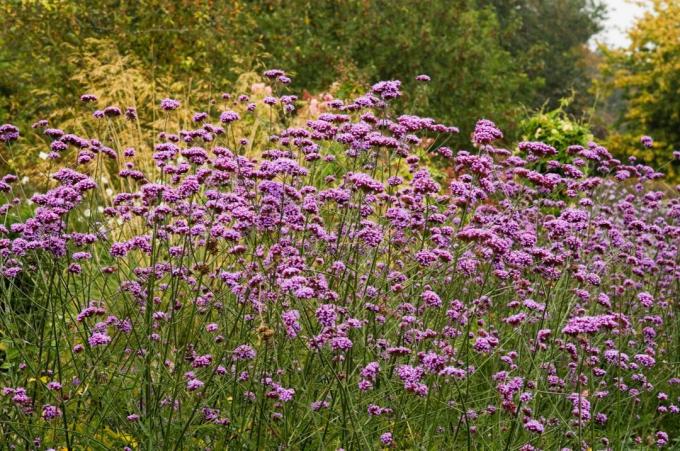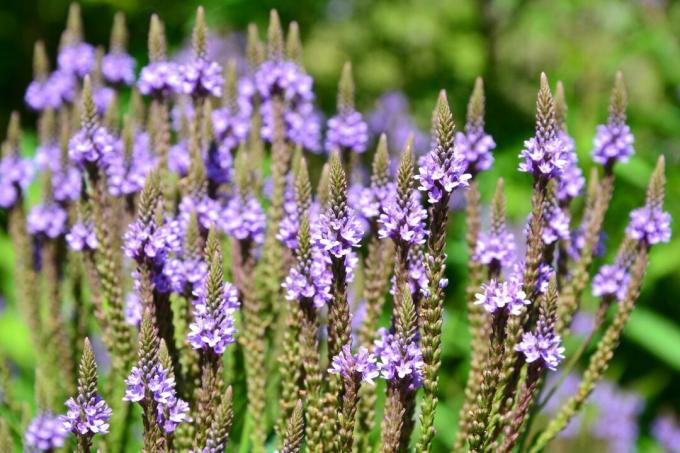With the numerous verbena species and varieties, it can be difficult to choose. The differences are not only in appearance, but also in the characteristics of the species.

The genus of vervain (verbena) is versatile and sometimes it is not so easy to find out where the differences between the species lie. For a better overview, we have compiled the most common verbena species and their varieties here.
contents
- Varieties and Species of Verbena: How Many Are There?
-
Vervain species and varieties at a glance
- Patagonian verbena
- Lance Vervain
- Stiff verbena
- Upright verbena
Varieties and Species of Verbena: How Many Are There?
To the iron herbs (verbena) include around 87 different species. However, not all of them are used as ornamental plants. Verbena species are distributed almost worldwide and differ accordingly, for example in terms of their winter hardiness. Of the most popular verbena species, there are now also some varieties that are characterized by certain growth traits or flower colors.

Vervain species and varieties at a glance
To make it easier to choose the right verbena variety for your own garden, we have put together a small selection of the most beautiful verbena species and varieties. This is certainly the best known True verbena (Verbena officinalis) used in medicine. Many other species, on the other hand, convince more with their ornamental value for the garden. Caring for the verbena species listed here is essentially the same as caring for common verbena. They only have to be watered during longer dry periods and fertilization at the beginning of the growing season is sufficient in good locations. This supports a rich flowering. A long-term fertilizer such as ours is suitable Plantura organic flower fertilizer, which you simply work into the ground. The nutrients are released gradually and are sufficient for the verbena in good locations for the entire growing season. All species also self-seed, so they can be propagated by sowing.
Tip: The Greek Verbena (Sideritis scardica) does not belong to the verbena genus, despite its name, but to the group of herbs (sideritis).
Patagonian verbena
The Patagonian Verbena (Verbena bonariensis) is also known under the names Argentine Verbena, Argentine Verbena or Tall Verbena. It is an annual to biennial, herbaceous plant that produces many small, violet flowers that are clustered in umbellate inflorescences. The flowering period extends from July to October. It grows as an upright nest and reaches heights of up to 120 cm. The bee-friendly verbena species is best planted in full sun. Otherwise, the Patagonian Verbena makes hardly any demands on its location. The soil should ideally be well-drained and fresh or slightly moist. You can propagate the Patagonian verbena by seeds, or simply leave the inflorescences in place so that they can self-seed and spread by themselves. It is also possible to use semi-lignified cuttings that are cut in the fall. About eight to ten plants fit on one square meter, creating an attractive overall picture. Other plants that you can combine the Patagonian verbena with are for example Mediterranean subshrubs such as rosemary (Salvia rosmarinus) and lavender (Lavandula angustifolia) that have similar site requirements.

Is Patagonian Verbena Hardy?Verbena bonariensis can withstand temperatures of up to
– Survive 12 °C, but should always be protected with a layer of mulch, such as leaves. The above-ground parts of the plant die off in winter. If it does not survive the winter, it usually survives by self-sowing.
As a cultivar is the Patagonian Verbena 'lollipop' famous. It remains significantly smaller than the species and reaches a height of about 60 cm with a compact habit. It is therefore also called small Patagonian verbena.
Lance Vervain
The lance verbena from North America shows a completely different inflorescence (Verbena hastata) in the flowering period from July to September. The small violet flowers are arranged in spikes in this species, similar to that of common verbena. Together with the lanceolate leaves and the upright growth, the verbena has more than earned its name. The species reaches heights of about 100 to 150 cm and is hardy up to
– 30 °C, so usually no additional protection is required. Since the plant dies above ground in winter anyway, it makes sense to cut it back before winter or at the latest until new growth begins. Verbena hastata grows best in sunny locations with well drained, fresh or moderately moist soil. When planting, care should be taken to ensure that there are no more than seven plants per square meter. In early summer, cuttings can be obtained from mature specimens for propagation.

In addition to the species are four varieties of Verbena hastata famous:
- 'Blue Spiers': Blue-purple flowers.
- 'Pink Spiers': Flowers white-pink.
- 'White Spiers': With white flowers.
- 'Rose': Flowers pink-pink.
Stiff verbena
Stiff vervain from South America (Verbena rigida) reaches heights of about 60 cm and forms spike-like inflorescences. However, the flowers appear to be arranged in a hemispherical arrangement. The pink flowers can be enjoyed over a long flowering period from June to October. The stiff verbena blooms most happily in locations with moderately nutrient-rich, well-drained soil in the sun and without wind. About three to five plants per square meter should be planted. The following varieties of stiff verbena are available:
- ‘Venosa’: Forms strong, pink flowers.
- ‘Lilac Blue’: Flowers in blue-purple and only about 40 cm high.
In contrast to the other verbena species, the stiff verbena does not tend to self-seed generously, which is why it is advisable to collect the seeds and prepare them.
Is stiff verbena hardy? The herbaceous plant loves warmth and is only partially hardy. It tolerates temperatures down to about -5 °C. As a rule, it is therefore kept as an annual plant in our latitudes. With proper winter protection, such as a thick layer of mulch, it can survive a mild winter. If the stiff verbena grows perennial, it develops a broad, sprawling growth habit, which has also given the species the name runner verbena.

Upright verbena
The Upright Vervain (Verbena stricta) is native to North America and can also be planted in our garden. Compared to the other verbena species, it forms quite large individual flowers that are arranged in spikes or in the form of cylinders. The spike then blooms from bottom to top during the flowering period from July to August. The flowering period is comparatively short, lasting only about four weeks. The annual to biennial herbaceous plant grows to a height of about 60 cm. It needs a sunny, warm spot and well-drained soil. This species is hardy but not particularly long-lived and can withstand temperatures down to -30 °C.

A distant relative of verbena is lemon verbena (Aloysia citrodora), even if they do not belong to the same genus. tips for Caring for Lemon Verbena and many other interesting articles on medicinal plants can be found in our magazine.



